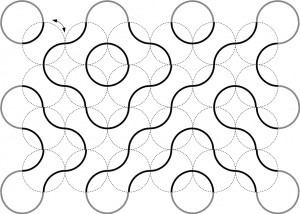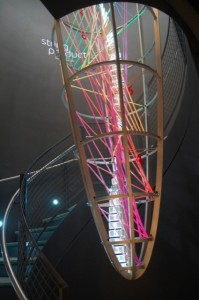Varsity Math, Week 17
This week, the Varsity Math team is visiting the National Museum of Mathematics. Naturally, they find a lot of puzzling situations there.
Beaver Bash
The team gets a look at the Museum’s newest exhibit, Beaver Run. In this exhibit, each of 24 turntables with two quarter-circle  track sections can be placed in either of two positions, 90 degrees rotated from each other, as shown in the diagram. The team members immediately make up a two-player game: the players take turns setting the position of a turntable, one at a time. Once a player has set the position of a given turntable, that turntable may not be rotated again. The first player wins if there are an odd number of loops of track at the end of the game (when every turntable has been set), and the second player wins if there are an even number of loops.
track sections can be placed in either of two positions, 90 degrees rotated from each other, as shown in the diagram. The team members immediately make up a two-player game: the players take turns setting the position of a turntable, one at a time. Once a player has set the position of a given turntable, that turntable may not be rotated again. The first player wins if there are an odd number of loops of track at the end of the game (when every turntable has been set), and the second player wins if there are an even number of loops.
Which player has a winning strategy in this game, and what is that strategy?
Staircase Surface
The team also loves to look at the giant light sculpture in the central well of the spiral staircase in the Museum. It consists of a circular paraboloid, a surface whose vertical cross sections are all parabolas and whose horizontal cross sections are circles. There are many lines of light connecting different points in the sculpture. Jean notices one in particular that starts at a point on the paraboloid 64 units vertically above the lowest point of the parabola, and passes through the vertical central axis (the line consisting of the centers of all of the circular cross sections) at a height of 24 units above that lowest point.
How many units vertically above the lowest point of the paraboloid does the line again intersect the paraboloid?
Solutions to Week 16
Champion Countdown. (A) There are 4·1016 = 4064 seconds worth of four-digit numbers, 3·900 = 2700 seconds of three-digit numbers, 2·90 = 180 seconds of two digit numbers, 10 seconds of one-digit numbers and 5·20 = 100 seconds of pauses for a total of 4064 + 2700 + 180 + 10 + 100 = 7054 seconds. Therefore, Skyler’s countdown must begin exactly 7054 seconds before midnight. 3600 seconds is one hour, and the remaining 3454 seconds is 57 minutes (= 60·57 = 3420 seconds) and 34 seconds. Therefore, the countdown must start at 10:02:26 pm on Dec 31. (B) 2015 seconds later, Skyler is still in the four digit numbers. The first 500 such numbers take 2000 seconds plus four pauses, for 2020 seconds. Therefore, at 2015 seconds, Skyler is almost finished with his 499th number, which is 2015 – (499 – 1) = 1517. (C) 2015 seconds before the end, Skyler still has 10 seconds of one-digit numbers to go, 180 seconds of two-digit numbers to go, and 1825 seconds of three-digit numbers and pauses to go. If there were no pauses, that would mean Skyler would have 608 three-digit numbers remaining, and so would be about to start 707. So Skyler will definitely pause just before saying 615, 515, …, 115 and 15, for at least seven pauses or 35 seconds. That means there are only 1790 seconds left for three-digit numbers, which is just more than enough for 596 three-digit numbers, meaning that Skyler would be about to say 695 and so be in the middle of saying 696.
Boxes not Urns. Looking back to answer (B) of the previous problem, we know that there are one red, five yellow, one green and seven blues in the box of tags before Emerson pulls two out. We just need to calculate the probability the two are different. It’s actually easier to calculate the probability that the two tags are the same color, since for that to happen they must either be yellow or blue. So we’ll do that calculation, and then subtract the result from one. There are a total of 14 tags in the box, so 14·13/2 = 91 pairs of tags that Emerson might have grabbed. Of these, 5·4/2 = 10 pairs are both yellow, and 7·6/2 = 21 pairs are both blue. So the probability the tags are the same color is 31/91 and the probability that they are different is 60/91.
New Year-amid. Since the probability the tags were the same color in the previous problem is 31/91, we know Ms. Leavenmath’s class has 31 students. Now suppose her class builds a pyramid with `N` levels; the pyramid will contain `1^2 + 2^2 + 3^2 + cdots + (N-1)^2 + N^2` blocks. There are a variety of ways to find a formula for this quantity, which is the sum of the first `N` squares; this reference shows that it is `(N(N+1)(2N+1))/6`, and gives several different derivations. Now we want the third smallest `N` such that this quantity is divisible by 31. Since 31 is prime, that means that either 31 divides evenly into `N, N+1`, or `2N+1`. The smallest number that 31 divides evenly into is 31 itself, so the three smallest `N` occur when `2N+1=31`, `N+1=30`, and `N=31`. Since these are `N=15,30`, and 31, respectively, the third smallest occurs with 31 layers, at which point each student gets `((31+1)(62+1))/6` red blocks. When one student combines them with an equal number of each of the other colors of the rainbow, that student has `32 · 63 = ` 2016 blocks with which to make a square prism of dimension 12×12×14 blocks.
Gonzi Scheme. For simplicity of writing the numbers, we’re going to work in millions of dollars in this solution. Suppose that Topnotch initially invests `I` million. Then after one month, the balance is `2·I – 1^2` millions of dollars. After two months, the balance is `4·I – 2·1^2 – 2^2`. After three months, `8·I – 4·1^2 – 2·2^2 – 3^2`. And after four months, it is `16·I – 8·1^2 – 4·2^2 – 2·3^2 – 4^2`. Now this is starting to get a little hairy, so let’s re-write using exponential notation for all of those terms that keep doubling: so the the balance after four months is `2^4·I – 2^3·1^2 – 2^2·2^2 – 2·3^2 – 4^2`. Let’s take a factor of `2^4` out front; the balance is `2^4(I – 1^2/2^1 – 2^2/2^2 – 3^2/2^3 – 4^2/2^4)`. Now it’s easy to see that pattern will continue; the balance after `n` months will be `2^n(I – 1^2/2^1 – 2^2/2^2 – 3^2/2^3 – cdots – (n-1)^2/2^(n-1) – n^2/2^n)`. In other words, the Topnotch account will never go bankrupt if for every whole number `n`, `I` is bigger than `1^2/2^1 + 2^2/2^2 + 3^2/2^3 + cdots + (n-1)^2/2^(n-1) + n^2/2^n`. The least such number is (actually by definition!) just the infinite sum `S = \sum_{n=1}^oo n^2/2^n`. To evaluate `S`, notice that `2S = \sum_{n=1}^oo n^2/2^{n-1} = 1 + \sum_{n=1}^oo (n+1)^2/2^n`. Subtracting `S` from both sides, we find that `S = 1 + \sum_{n=1}^oo ((n+1)^2 – n^2)/2^n = 1 + \sum_{n=1}^oo (2n+1)/2^n = 1 + \sum_{n=1}^oo n/2^{n-1} + \sum_{n=1}^oo 1/2^n = 2 + \sum_{n=1}^oo n/2^{n-1}`. Call the infinite sum on the right-hand side `T`. Using the same trick, `2T = \sum_{n=1}^oo n/2^{n-2} = 2 + \sum_{n=1}^oo (n+1)/2^{n-1}`. Subtracting `T` from both sides, `T = 2 + \sum_{n=1}^oo ((n+1) – n)/2^{n-1} = 2 + \sum_{n=1}^oo 1/2^{n-1} = 2 + 2 = 4`. Hence, `S=6`, and therefore the minimum initial investment that prevents bankruptcy is $6 million.
Recent Weeks
Week 16: Gonzi Scheme & New Year-amid, solution to Boxes Nest
Week 15: Boxes not Urns & Boxes Nest, solution to Crooked Clock
Week 13: Try Angles & Great Lengths, solution to Daunting Doorways
Links to all of the puzzles and solutions are on the Complete Varsity Math page.
Come back next week for answers and more puzzles.


